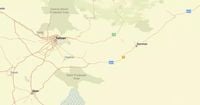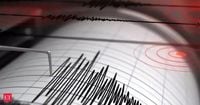On June 20, 2025, a moderate 5.1 to 5.2 magnitude earthquake rattled northern Iran, striking near the city of Semnan at a shallow depth of 10 kilometers (6.2 miles), according to data from the United States Geological Survey (USGS) and Iran's Tasnim news agency. The tremor was felt as far as Tehran, the nation’s capital, and alarmingly close to critical military and nuclear sites, including the Fordow nuclear enrichment facility in Qom Province and the Semnan Space Center and Missile Complex, both managed by Iran’s military.
The earthquake occurred at approximately 9:19 p.m. local time (7:49 UTC), with the epicenter located roughly 35 to 37 kilometers southwest of Semnan, about 145 miles east of Tehran. Despite the quake’s moderate strength, initial reports indicate that the shaking was light, and there have been no immediate accounts of damage or casualties. Still, the geographic and political context surrounding the event has raised concerns.
Iran is situated on the seismically active Alpine-Himalayan belt, making it one of the most earthquake-prone countries worldwide. It experiences around 2,100 earthquakes annually, with 15 to 16 registering magnitudes of 5.0 or higher. This particular quake’s proximity to sensitive military installations has added an extra layer of tension, especially as it coincided with an ongoing conflict between Iran and Israel.
At the time of the earthquake, Israel was conducting repeated airstrikes across Iran, targeting various military facilities. The Israeli Defense Forces (IDF) claimed responsibility for dismantling three surface-to-surface missile launchers allegedly prepared to launch missiles toward Israel. These strikes reportedly hit an Iranian air defense site known as Magar in the Behmai province in southwestern Iran.
The IDF also announced that a "cell" of Iranian commanders and soldiers had been eliminated, including an Islamic Revolutionary Guard Corps (IRGC) base commander responsible for 15 missile launchers. According to the IDF’s official English-language social media, a remotely piloted aircraft identified the group en route to carry out a missile launch, which was subsequently thwarted.
Local Iranian media acknowledged the earthquake but reported a slightly higher magnitude of 5.2, with some outlets even suggesting it was as strong as 5.5. Speculation circulated on social media, including a public Telegram board run by an Iranian blogger who claimed the quake was caused by IRGC testing activities, though these claims remain unverified.
The timing of the earthquake amid Israel’s airstrikes has led to heightened alertness in the region. The Semnan area, housing the missile complex and space center, is a strategically significant location for Iran’s military capabilities. Meanwhile, the Fordow nuclear enrichment facility in Qom Province, buried deep beneath mountainous terrain, was also shaken by the tremor. Although Israel has largely refrained from attacking Fordow directly, it has been active in targeting other sites across Iran.
Experts believe that Israel currently lacks the weaponry to destroy Fordow effectively and is seeking U.S. involvement in the conflict. The United States possesses the Massive Ordnance Penetrator (MOP), a 30,000-pound bomb designed to penetrate and destroy underground structures like Fordow. As of June 19, 2025, U.S. President Donald Trump was deliberating whether to commit American forces, stating, "I will make my decision whether or not to go within the next two weeks." This decision carries significant implications for the conflict’s escalation and regional stability.
In the diplomatic arena, Iranian Foreign Minister Abbas Araqchi met with European officials in Geneva on June 20, 2025. Ahead of these discussions, he made clear Iran’s stance, stating, "We have explicitly told [the U.S.] that as long as the aggression and attacks continue, there is simply no room for talk of dialogue or diplomacy." This hardline position underscores the deepening crisis and the challenges facing any potential peace negotiations.
The earthquake’s geological significance is compounded by the volatile political landscape. Iran’s location on multiple fault lines means seismic activity is a constant threat, but the coincidence of this quake with escalating military actions adds an ominous dimension. While no immediate damage has been reported, the presence of critical infrastructure and military assets near the epicenter means authorities are likely monitoring the situation closely.
Seismologists continue to analyze the data, with the USGS noting that the reported magnitude may be revised as more information becomes available. Aftershock data, collected within 100 miles and seven days of the initial quake, is also under review to assess any further seismic risks.
As Iran and Israel remain locked in a tense standoff, the earthquake serves as a stark reminder of the region’s fragility—both natural and political. With Israel’s airstrikes ongoing and the possibility of U.S. intervention looming, the coming weeks will be critical in determining the trajectory of this multifaceted crisis.
For now, residents in Tehran, Semnan, and surrounding areas are left to grapple with the dual threats of geopolitical conflict and natural disaster, hoping that neither escalates beyond control.





